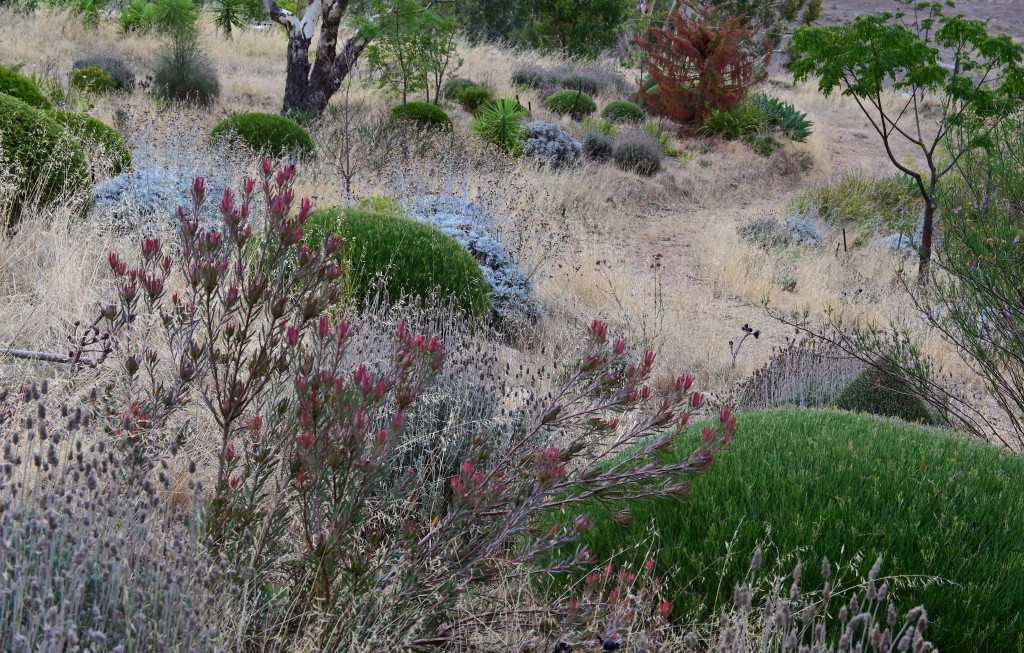‘At that point, are we really being honest?’.
I loved this moment in my conversation with Monaco-based and multi-award-winning garden designer James Basson, for our latest symposium.
He was making the point that it’s easiest for him to design and manage a really striking landscape when he’s working in very mean conditions, in which growth is naturally suppressed by poor soils and hostile conditions. In such landscapes, the surface of the ‘soil’ (if there is any) is usually covered in gravel or some other mineral substrate, and there’s plenty of visible space between plants. That such a setup makes a satisfying result easier to achieve is itself sufficiently mind-bending to stop you in your thought-tracks for a while.

But then he adds that while he’d like to design gardens like that, or that look like that, across the geographical range over which his work spreads, he’s often working on what are quite agricultural soils, or at least post-agricultural soils. And that’s when the above question arises. He says that it’s possible, by stripping back top soil or bringing in loads of gravel, to create a tough looking garden on this soils, but ‘at that point, are we really being honest?’
Consequently, he sees his practice moving away from what, in an earlier email exchange with me, he referred to as ‘the mineral and the mean’ – the very look he is perhaps best known for (see garden pic above, as an example). And that he’s doing so in order to be more honest – to better honour what US-based designer and author Thomas Rainer calls ‘landscape memory’, that being what the landscape in its raw form either was, or wants to be.

This helps lasoo many free-range thoughts for me, in reference to whole new area I’d planned for my own garden. My practice of not watering at home (simply because I don’t have the water supply) felt like it was forcing me into a much more mediterranean mode of low, clipped shrubs (as if wind- or goat-pruned) spangled with feathery grasses. But as much as I love that look, I couldn’t work out how to reconcile that with three very wet springs which can drown mediterranean drought-loving plants in a matter of days, and induces an unmanageable wave of juicy, verdant weed-growth. Nor with the fact that it would require that I import a whole lot of gravel into an area that has no sense of the mean and mineral. There’s not a rock to be seen within cooee range.

So we face the same challenge, James Basson and me. Indeed, the annual rainfall around Antibes, where much of his work is based, is 700mm – very much like mine. So while it’s not generous, it’s not arid either. The necessity is to come up with planting that can be what it wants to be – rich, grassy, and verdant in late winter and spring, and then dry and pared back in summer. And look compelling and engaging in each of its seasonal manifestations.
I’ll be watching him closely. And furiously wracking my brains, and trialling ideas, at the same time.
The ‘Principles of Garden Design’ symposium, including the full interviews with each of the participants, is available for viewing until June 30. Click here for more information and tickets.
I love the term landscape memory – it’s such an interesting conundrum – we gravitate to gardens that have structure and bring some order to nature, to show that man has had an impact – even in a ‘new perrenial’ garden, trying to look whimsically unstructured through matrix planning. Yet, we see that that need to add our own stamp can be far less sustainable and bring higher total emissions footprint through design, implementation and maintenance. Also truly honouring the landscape memory means perhaps not going with planting selections that are in fashion elsewhere, acquiring an intimate knowledge of local ecosystems (not always readily available) and being willing to experiment – which means added time to translate the vision into the final physical version. I sense it’s where we need to go, but in our culture driven by immediacy, a long transformational shift is required to value gardens sympathetic to their landscape memory.
Thanks for this discussion, Michael. I’ve listened to your conversation with James Basson a few times now ( I know, a bit sad😆), and I’m happily challenged by the idea of “ being honest”. Sometimes it feels like we have a tug of war going on between working well with the way things are in our garden and how conditioning propels us to the way it could look with more inputs. 😂. It’s great to have the gardening cage rattled.
Interesting ,for those of us in Southern Tasmania that experience less than 600mm annual rainfall we need to start thinking outside of conventional methods.